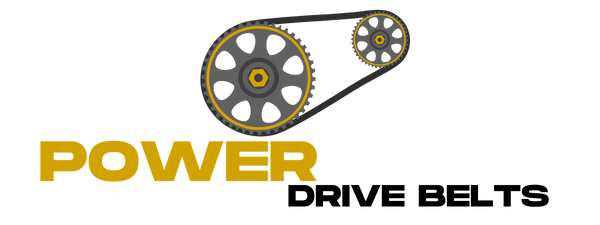Choosing the Right V‑Belt Material: Rubber vs. Kevlar vs. EPDM
Share
Choosing the Right V‑Belt Material: Rubber vs. Kevlar vs. EPDM
Selecting the optimal V‑belt material ensures reliable power transmission, maximizes belt life, and prevents unexpected downtime. In this guide, you’ll learn when to choose natural rubber, Kevlar‑reinforced, or EPDM belts, based on performance requirements and operating conditions.
Why Belt Material Matters
Load Capacity: Different materials handle tensile stresses and shock loads differently.
Temperature & Environment: Heat, ozone, chemicals, and UV exposure vary by application.
Longevity & Maintenance: Material properties affect wear rate, stretch, and required tensioning.
Cost‑Effectiveness: Balancing upfront cost against lifespan and downtime savings.
Overview of Common V‑Belt Materials
1. Natural Rubber
What it is: Made from vulcanized natural latex with embedded tensile cords (often polyester or cotton).
Key Traits:
Excellent grip and flexibility
Good damping of shock loads
Moderate temperature range (–20 °F to 140 °F)
Prone to ozone and oil degradation if unprotected
Best for: Light‑ to medium‑duty drives in clean, moderate‑temperature environments.
2. Kevlar‑Reinforced (Aramid)
What it is: Synthetic aramid fibers (e.g., Kevlar) as tensile cords within an EPDM or neoprene matrix.
Key Traits:
Very high tensile strength and minimal stretch
Outstanding abrasion and cut resistance
Wide temperature range (–65 °F to 265 °F)
Higher upfront cost
Best for: High‑load, continuous‑duty industrial drives and applications with frequent start/stop cycles.
3. EPDM (Ethylene Propylene Diene Monomer)
What it is: Fully synthetic rubber compound, often with polyester or aramid cords.
Key Traits:
Superior heat, ozone, and weather resistance
Excellent chemical resistance (acids, alkalis)
Good flexibility at low temperatures (down to –50 °F)
Slightly lower coefficient of friction than natural rubber
Best for: Outdoor equipment, HVAC systems, and corrosive or high‑heat environments.
Side‑by‑Side Material Comparison
| Property | Natural Rubber | Kevlar‑Reinforced | EPDM |
|---|---|---|---|
| Tensile Strength | 4,000–6,000 psi | 10,000–15,000 psi | 5,000–8,000 psi |
| Temp. Range | –20 °F to 140 °F | –65 °F to 265 °F | –50 °F to 230 °F |
| Elongation @ Break | 200–400% | 2–5% | 100–300% |
| Abrasion Resistance | Good | Excellent | Very Good |
| Ozone/UV Resistance | Fair | Excellent | Excellent |
| Chemical Resistance | Poor | Good | Excellent |
| Cost (per ft) | $0.50–$1.00 | $1.50–$3.00 | $0.75–$1.50 |
| Typical Applications | Light machinery, DIY | Heavy industrial drives | HVAC, outdoor, corrosive |
How to Choose the Right Material
Assess Operating Conditions
High temperatures or outdoor exposure → EPDM
Frequent shock loads or heavy horsepower → Kevlar‑Reinforced
Clean, moderate environments with budget constraints → Natural Rubber
Evaluate Load & Speed Requirements
High RPM and tension stability → Kevlar (minimal stretch)
Moderate speed, light load → Natural Rubber
Consider Maintenance Intervals
Limited access or hard‑to‑service equipment → favor longer‑lasting Kevlar or EPDM.
Frequent inspections possible → Natural Rubber may suffice.
Factor in Total Cost of Ownership
Calculate downtime costs vs. belt price. Longer life often offsets higher material cost.
Material‑Specific Use Cases
Garden Tractors & Mowers: EPDM belts resist sunlight, oil, and grass‑clipping chemicals—ideal for outdoor use.
Factory Conveyors & Presses: Kevlar‑reinforced belts handle heavy loads and constant cycling without significant elongation.
Home Workshop Tools: Natural rubber belts provide sufficient performance at the lowest cost for intermittent light‑duty use.
Frequently Asked Questions
Q1: Can I replace a natural rubber belt with EPDM?
A: Yes—EPDM’s temperature and chemical resistance often exceed natural rubber, though you may need to adjust tension due to slightly different elasticity.
Q2: Why are Kevlar belts more expensive?
A: Kevlar (aramid) fibers offer exceptional tensile strength and minimal elongation, which translates into longer life under heavy loads, justifying the higher price.
Q3: How often should I inspect my belts?
A: Check every 500 hours of operation, or quarterly—look for cracks, glazing, and proper tension. Harsh environments may require more frequent checks.
Q4: What if my application involves oil or grease?
A: Avoid natural rubber; use oil‑resistant EPDM or neoprene compounds with aramid reinforcement to prevent premature degradation.
Q5: Are there specialty compounds for extreme environments?
A: Yes—silicone or fluorocarbon‑based belts exist for very high temperatures or chemical exposure. Consult your supplier for custom solutions.
